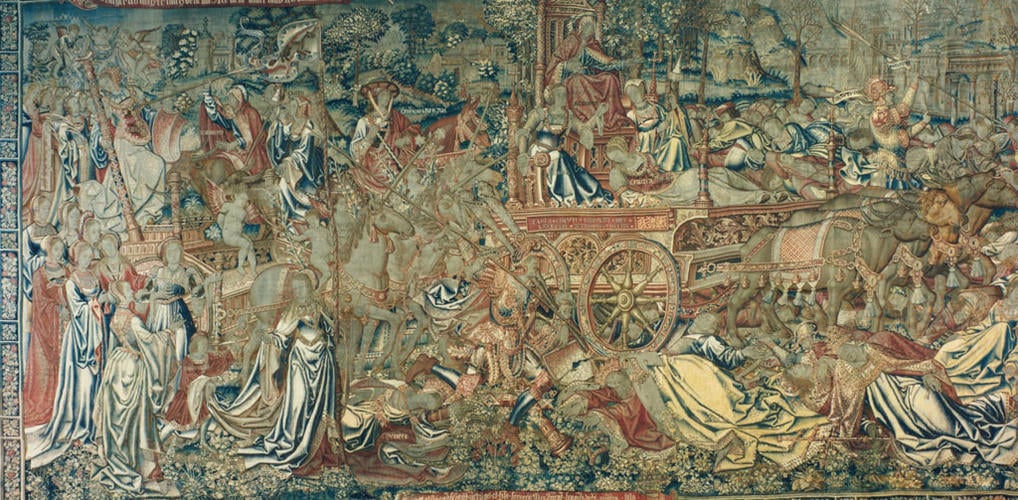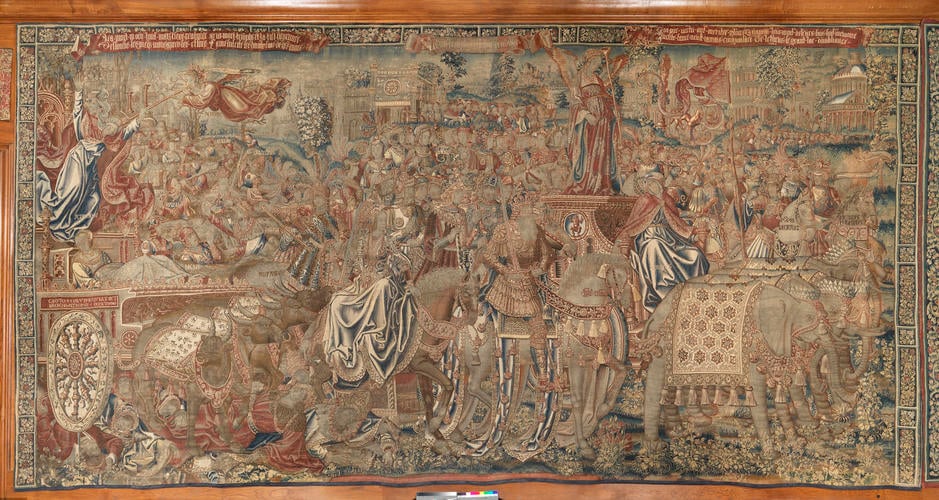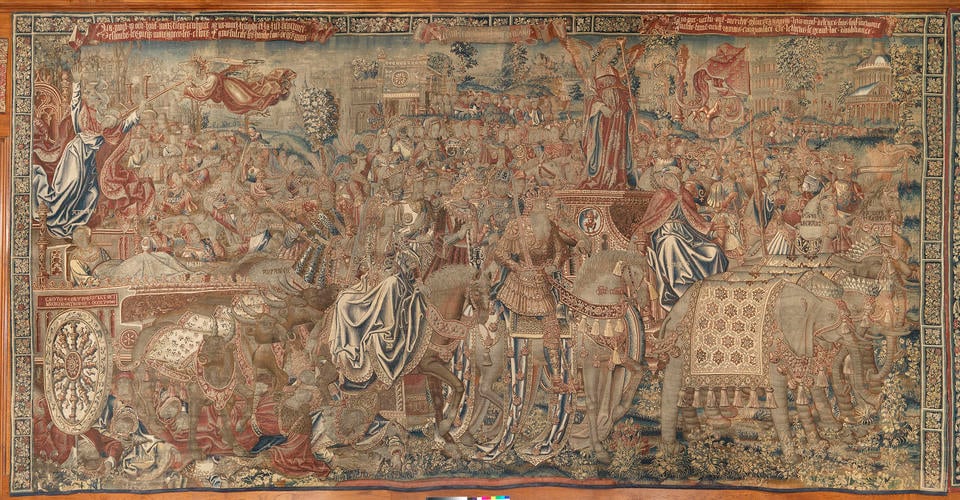The Triumphs of Petrarch 1500-23
Woven silk and wool tapestry | 403.0 x 823.0 cm (whole object) | RCIN 1270

Flemish
Master: The Triumphs of Petrarch Item: Triumph of Death over Chastity 1500-23

Flemish
Master: The Triumphs of Petrarch Item: Triumph of Fame over Death 1500-23

Flemish
Master: The Triumphs of Petrarch Item: Triumph of Fame over Death 1500-23

Flemish
Master: The Triumphs of Petrarch Item: Triumph of Time over Fame 1500-23

Flemish
Master: The Triumphs of Petrarch Item: Triumph of Death over Chastity 1500-23





-
Four panels from a series of Flemish tapestries depicting the Triumphs of Petrarch, taken from the poem I Trionfi by Petrarch (1304-74), depicting: the Triumph of Death over Chastity (two versions); the Triumph of Fame over Death; and the Triumph of Time over Fame. Each panel has a floral border, with inscriptions in French above and Latin below.
The Triumph of Death over Chastity depicts the triumphal car of Chastity, drawn by unicorns, boarded by two of the Fates, Clotho and Atropos. Atropos directs a javelin at her bosom. In The Triumph of Fame over Death the car of Fate or Death is drawn by four bulls, while Fame rides a triumphal car drawn by elephants. The Triumph of Time over Fame shows Fame, prostrate in her car, drawn away by her elephants. Old Time with his scythe is drawn on a car by winged horses.
The complete series included six designs, each of which illustrated the triumph of one of Petrarch's allegorical personifications: Love, Chastity, Death, Fame, Time and Divinity. In Petrarch's poem only the first personification, Love, was provided with a chariot, but by the mid-fifteenth century Florentine artists were depicting each triumph in this way. The design series from which the Hampton Court tapestries derive followed this model, with the variation that each scene showed two chariots; on the left is the chariot of the waning power at the moment of its defeat, while on the right is the chariot of the ascendant power, with the overthrown power at its feet.
In Petrarch's poems Love made the first conquest and is the only one that Petrarch describes as having a triumphal procession, the key figure riding a chariot. However, early editions of I Trionfi and representations of the Triumphs from the mid-fifteenth century onwards gave each victor a triumphal carriage. This model was disseminated through prints.
The designs for this series appear to have been created for the French king, Louis XII, on the basis of an illuminated manuscript of the Triumphs of Petrarch presented to him by Georges d'Amboise, archbishop of Rouen, in about 1503.
Cardinal Wolsey was renowned for his fondness for tapestries, having purchased this set in 1523 from the executors of the Bishop of Durham. George Cavendish, Wolsey's gentleman usher and biographer, wrote of his collection: "My chamber garnysht / with arras fynne. // Importyng personages. / of the lyvelyest kind// And whan I was disposed / in them to dyne// My clothe of estate / there redy did I fynd // Ffurnysshed complett accordyng to my mynd."
Two sets were recorded in Wolsey's collection: one from the Bishop of Durham, and another, possibly the gift of Henry VIII. It is unknown whether the present set represents pieces from one set or a mixture of the two.
Three panels of the same series are in the V&A.
Text adapted from Henry VIII and the Art of Majesty: Tapestries at the Tudor Court by Thomas P. Campbell and from an exhibition label by Lucy Whitaker, 2012.Provenance
Purchased by Cardinal Wolsey from the executors of the Bishop of Durham in 1523 (Bibl.Harl. 599). Between 1659-75 three pieces were on display in the King's Presence Chamber, Hampton Court Palace, and one in the room "formerly the Lord Chamberlains Withdrawing Roome". From 1842 they have been on permanent display in the Great Watching Chamber.
-
Creator(s)
(nationality)Acquirer(s)
-
Medium and techniques
Woven silk and wool tapestry
Measurements
403.0 x 823.0 cm (whole object)
403.0 x 815.0 cm (whole object)
440.0 x 815.0 cm (whole object)
404.0 x 625.0 cm (whole object)
Category
Object type(s)
Subject(s)
Alternative title(s)
The Triumph of Death over Chastity
The Triumph of Fame over Death
The Triumph of Time over Fame









